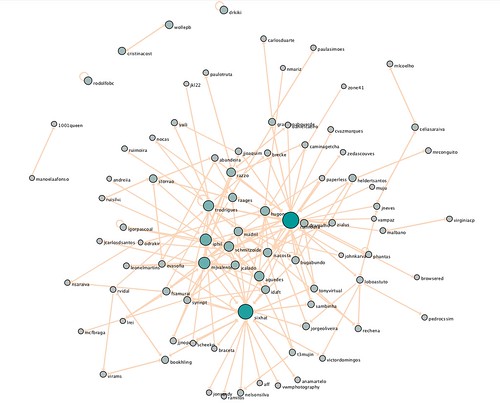 Já está disponível a Newsletter de Complexidade de Maio da ASSYST. A cada mês que passa está a evoluir para ficar melhor. A atender pela dinâmica que começa a ganhar está a tornar-se um caso de sucesso. Para já penso que é mais um ponto de partida do que um ponto de chegada, mas em todo o caso ao ritmo a que evolui poderá tornar-se um caso popular de sucesso. Se quiser pode descarregar PDF da Newsletter do ASSYST/CSS.
Já está disponível a Newsletter de Complexidade de Maio da ASSYST. A cada mês que passa está a evoluir para ficar melhor. A atender pela dinâmica que começa a ganhar está a tornar-se um caso de sucesso. Para já penso que é mais um ponto de partida do que um ponto de chegada, mas em todo o caso ao ritmo a que evolui poderá tornar-se um caso popular de sucesso. Se quiser pode descarregar PDF da Newsletter do ASSYST/CSS.
John Conway´s Game of Life em HTML5
O HTML5 está aí para mudar a web pelo que decidi começar a brincar com algumas features que só existem no HTML5. E para começar a perceber o que vai mudar nada melhor do que começar com algo tão dinâmico como o Jogo da Vida do John Conway em HTML5…
(Só para quem estiver a utilizar Safari ou Google Chrome – Firefox e Opera tem suporte parcial mas também dá.)
Ant Encounters: Interaction Networks and Colony Behavior
Ants are more than a hundred million years older than humans, and they cover the land surface of the planet. Probably peo- ple have always watched ants, and probably they have always asked the same question: How can ants get anything done when no one is in charge? Whoever wrote Proverbs 6:6 put it this way: “Look to the ant, thou sluggard—consider her ways and be wise. Without chief, overseer or ruler, she gathers the harvest in the summer to eat in the winter.” The history of our understanding of ant behavior is the history of our changing views of how organizations work.Deborah M. Gordon in Ant Encounters: Interaction Networks and Colony Behavior (chatper 1 – pdf)
Synchronization of Chaotic Lorenz Attractors
Imagine that at each time step you magically connect the X component of two systems of Lorenz equations, meaning that the value of X used in the equation for attractor 1 is copied over to attractor 2. Then you compute the X,Y and Z at t+1 for both attractors as usual.
<p>In the above applet you see this effect. The continuous line is attractor 1 (the reference) and the dashed lines are from the attractor 2 (the coupled attractor), meaning that at each time step the X value from 1 is copied over to 2.</p>
<p>The white line measures the distance between two trajectories as time passes. In this case we can quickly see it dropping down to zero and synchronization occurs.</p>
<p>This changes the behaviour of the system completely. Instead of being two systems with divergent trajectories they get closer and closer until finally they overlap perfectly, travelling in sync through space.</p>
more details at the Lorenz Sync Page (with extra applets)
Working Papers – The Observatorium, Variation of Information and stuff…
Rodrigues, D. (submited to ECCS’10); The Observatorium – The structure of news: topic monitoring in online media with mutual information
Abstract: Large, real time text classification systems are becoming a popular topic. We present a method for automatically extracting correlated news from online media using a dynamic similarity graph and use the variation of information as a measure to identify topics, lifespan and key terms. The presented method has the advantage of requiring no human intervention or training and having no pre-assigned categories because they emerge from the dynamics of the generated network.
And this is the reason why I’ve been a bit away from blogging lately… Now… next deadline is by March 26 for Open Source Intelligence & Web Mining 2010… and then to Brussels for an ASSYST meeting. It’s going to be a full March…
1D synchronization in coupled oscillators
Model Description
Each falling dot is one oscillator. Each vertical line is a dot “flashing”.
When each oscillator hits the ground he “flashes” and his position is reset to the top
When it “flashes” it affects a certain number of neighbours under a radius (coupling distance that you can control).
These neighbours loose an amount of energy that pulls them near the ground and in effect if this is enough to hit the ground then they will also flash simultaneously with the first dot and affect it’s own neighbours.
You can control the distance of the coupling (or the radius) by clicking and dragging along the XX axis. The YY axis controls the refresh rate of the simulation
Clicking in the right bottom square you can randomize and restart the simulation
References
Kuramoto, Y. (n.d.). Self-entrainment of a population of coupled nonlinear oscillators. In International symposium on mathematical problems in theoretical physics, Lecture notes in Physics (Vol. 39, p. 420-422). Springer.
Strogatz, S. (2003). Sync: The emerging science of spontaneous order. Library. Hyperion.
Guo, W., Austin, F., & Chen, S. (2010). Global synchronization of nonlinearly coupled complex networks with non-delayed and delayed coupling. Communications in Nonlinear Science and Numerical Simulation, 15(6), 1631-1639. doi: 10.1016/j.cnsns.2009.06.016.
Complexidade: As ferramentas do ofício

Todas as áreas científicas tem as suas ferramentas. Muitas vezes em relação aos sistemas complexos me é perguntado “o que devo saber/utilizar/escolher?”em termos de ferramentas computacionais. A lista seguinte de ferramentas para o investigador é apenas uma pequena lista com as minhas opiniões no seguimento de uma outra lista que fiz sobre as plataformas de agentes para simulação há cerca de um ano.
Anatomia de um motor de busca social de larga escala.
Isto promete nos próximos dias mexer com a forma como as redes sociais são encaradas. Pelo menos a coragem para imitar o título do paper “Anatomy of a Large-Scale Hypertextual Web Search Engine” dos fundadores do Google está lá.
O paper promete:
The paper describes the fundamental differences between the traditional “Library” paradigm of web search — in which answers are found in existing online content — and the new “Village” paradigm of social search — in which answers arise in conversation with the people in your network. We explain that in social search:Users can ask questions in natural language, not keywords Content is generated “on-demand”, tapping the huge amount of information in peoples’ heads The system is fueled by the goodwill of its users
O paper [pdf] de Damon Horowitz e Sepandar D. Kamvar vai ser apresentado na WWW2010 dentro de alguns meses.

